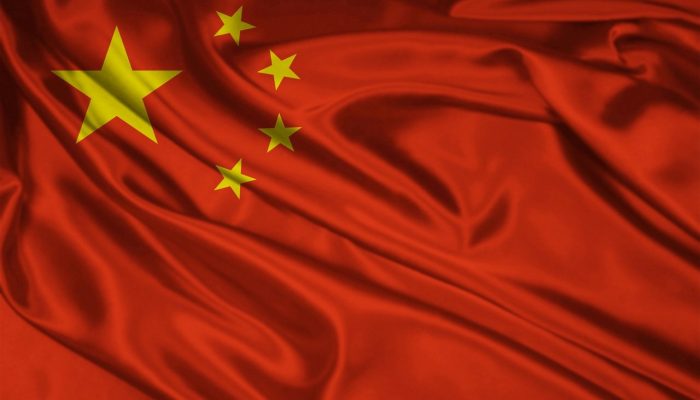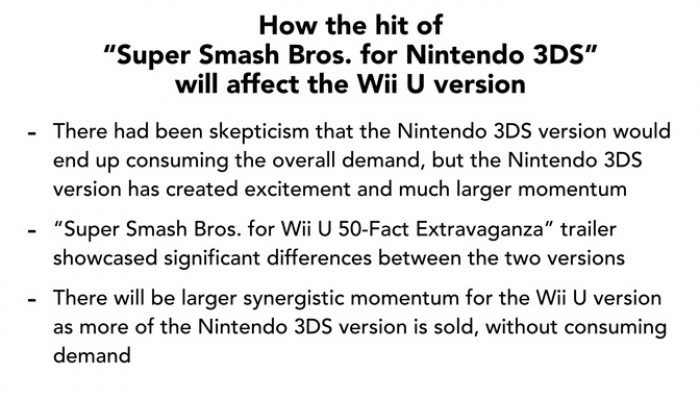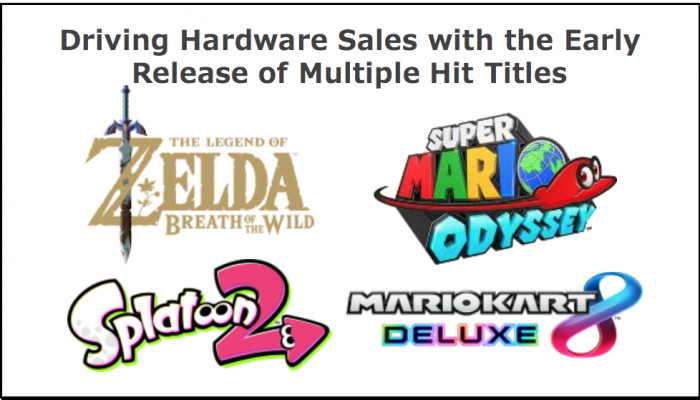 All of a sudden, investors are a lot more friendly with the success of Nintendo Switch.
All of a sudden, investors are a lot more friendly with the success of Nintendo Switch.
☆ NintendObs Event – Nintendo FY3/2017.
Question 1:
I would like to ask about the reasoning behind the number projected for the Nintendo Switch software shipments during this fiscal year (35 million units). While you have stated that you will present new business flows in the future and expect to generate synergy between the smart-device and game software businesses, it seems that the hardware attach rate for the Nintendo Switch software in this fiscal year is low compared to the rate for Wii U from the year of launch through the end of the following fiscal year. What factors influenced this determination – was it because Nintendo Switch launched outside of the holiday season, because you expect download sales to grow, because you plan to bundle major titles with hardware, or because the software lineup is insufficient? Please provide more information on the background for determining the planned shipment numbers for this fiscal year.
Answer 1:
Tatsumi Kimishima (President):
We are planning to ship 35 million units of the Nintendo Switch software worldwide this fiscal year. For Wii and Wii U, which launched during the holiday season in November, the attach rates for software through the end of the fiscal year in which each launched (the following March) were 4.9 units and 3.9 units per hardware unit, respectively. Nintendo Switch did not launch during the holiday season, but the software attach rate in under a month following its launch in March was 2.0 units. These differences are due to the timing and cannot be compared directly. Mario Kart 8 Deluxe, which is releasing today, has been highly anticipated by consumers and in fact currently has more momentum than we expected. We believe it is most important to convert this anticipation to sell-through and bring enjoyment to our consumers. Consumers are also looking forward to future titles in the Nintendo Switch lineup, including ARMS and Splatoon 2, so we are aiming for an attach rate of 3.5 units to 4 units over this fiscal year, comparable to that of Wii and Wii U.
Question 2:
How are you estimating the contribution of the smart-device business to sales and profit in the financial forecast for this fiscal year? It seems there has been a gap compared to market expectations, so please explain in as much detail as possible.
Answer 2:
Kimishima:
You may have already grasped the general scale from the information provided in our Earnings Release, but sales in the smart-device-related business in the last fiscal year were under 20 billion yen. In this fiscal year, we will continue service for the smart-device applications we have already released to bring further enjoyment to our consumers, and we plan to expand the smart-device business by releasing two to three new titles. However, I would hesitate to declare that sales for this fiscal year will immediately jump to four or five times that of the last fiscal year. Of course, we are aiming to expand this business, but the financial forecast for this fiscal year does not involve that degree of rapid expansion.
Question 3:
If demand for Nintendo Switch reaches the same levels that Wii did, isn’t it likely that the product will be sold out during the holiday season if you can’t secure sufficient inventory levels by the fall? Are you taking any steps to address this, such as establishing an expandable assembly line?
Answer 3:
Kimishima:
Our initial plan for the Nintendo Switch hardware shipments for the last fiscal year was 2 million units, but we saw the high anticipation from consumers prior to launch and began additional production, allowing us to ultimately ship 2.74 million units. We are planning to ship 10 million units this fiscal year, and this figure takes into account the fantastic response we have received from consumers. Planning to ship 10 million units means that we actually plan to produce more than that including units in our warehouse and in-transit product. We are not currently producing this full amount all at once. We expect that the number of consumers who want to buy the hardware will increase as we release titles such as ARMS, Splatoon 2 and Super Mario Odyssey, so our current production model takes that into account.
Question 4:
I think it is incredible that you were able to predict ahead of time that shipments of The Legend of Zelda: Breath of the Wild for Nintendo Switch would surpass the number of hardware units shipped. The late President Iwata declared that you would be reconsidering many conventions, and I feel that your way of thinking has changed considerably in areas such as hardware launch timing and price, software lineup and demand forecasting. Can you explain what kinds of changes have occurred?
Answer 4:
Kimishima:
We are deeply thankful for the wonderful response to The Legend of Zelda: Breath of the Wild and the fact that we were able to ship more units than we did of the Nintendo Switch hardware. Since The Legend of Zelda series is very popular in Europe and in particular in the U.S., and the hardware launch was in March, we thought that we might end up with different results from a holiday season launch (when a wider range of consumers are likely to make purchases), and so we expected that there may be a high ratio of consumers who purchased this game along with the hardware.
The result was exactly as expected in the U.S., but the game is much larger in scale than previous games, and it reached greater popularity than we had expected in Europe and Japan as people tried it themselves or watched others play. Reviews of this game prior to release were also very helpful in communicating its appeal. Ultimately, we were able to achieve these results because of the response not only from fans of The Legend of Zelda series, but also from consumers who had played a Zelda game in the past and wanted to play one again, as well as consumers who had never played a Zelda game before but who heard the buzz and wanted to play.
We would certainly like to be able to predict the worldwide popularity of The Legend of Zelda: Breath of the Wild, as you suggest, but we are still not able to forecast to that degree of accuracy. The end result was that the number of units of this game shipped was higher than the number of units of hardware shipped.
Question 5:
I’d like to hear your thoughts on the profitability of the Nintendo Switch platform. You mentioned previously that hardware pricing is set just high enough to stay out of the red, but there are an abundance of accessories for Nintendo Switch, while download sales, including add-on content for The Legend of Zelda: Breath of the Wild, are shifting into high gear, with a paid online service on the way. And on the promotion side, I see your eSports and Nintendo Direct initiatives as being more efficient, and I get the impression that marketing costs are more or less under control within the second year after a hardware launch. I would imagine your revenue model for Nintendo Switch is going to be different from what it was for past hardware, but can we also expect profitability to be higher than before?
Answer 5:
Kimishima:
We priced the Nintendo Switch hardware to have no negative impact on overall earnings. As for the profitability of the hardware, our production quantities will need to reach a certain level before we see any cost reductions. Volume efficiencies will start to emerge once we produce the 10 million units we expect to ship this fiscal year, but we will not get the benefit of this right away. Looking ahead, we do expect that the number and variety of the Nintendo Switch accessories will help grow our business. With regards to promotional activities, it can be difficult for consumers to really get to realize how compelling the new play style Nintendo Switch offers is through traditional marketing. That is why we have launched new initiatives, including traveling to a variety of different locations to let consumers experience the unique fun of playing Nintendo Switch for themselves, while continuing to advertise proactively in this fiscal year. Our paid online service for Nintendo Switch is scheduled to start in the latter half of this fiscal year.
Again, we will not necessarily see results from these different strategies immediately at the outset of this fiscal year, but I believe we will see profitability continue to increase alongside the growth of our business as we move forward according to our sales strategy, especially if we do well during the year-end shopping season.
Question 6:
I’d like to know as much as you can share about the basis for your short and medium-term sales forecasts of Nintendo Switch. In particular, are you expecting 10 million hardware shipments during this fiscal year because that’s the number your total anticipated demand in each region led you to, or are you looking at your software lineup for this period and predicting how much hardware you think you can sell? Also, you have been quoted in the media as saying that you want sales of Nintendo Switch to match the Wii sales. Should we take that to mean that your sales target for hardware is going to be 100 million units? If so, then do you envision Nintendo Switch selling not just one per household, but one per person?
Answer 6:
Kimishima:
We set this fiscal year’s 10 million shipment forecast for Nintendo Switch based on the fact that we were able to ship 2.74 million units during the last fiscal year, which was well above our initial forecast of 2 million units, combined with the response our sales offices around the world have reported from retailers and consumers about the software we will be releasing during this period. Mario Kart 8 Deluxe was released today and although we did not cover it when creating our sales plans, it has gotten especially positive reviews. Feedback from consumers at our ARMS and Splatoon 2 preview events has been positive, as well. We have also gotten good feedback about 1-2-Switch, which has already been released, and offers consumers a new gaming experience that takes advantage of the unique strengths of Nintendo Switch. All this together gives me the sense that Nintendo Switch is going to outperform our initial expectations.
For us, being able to reach an installed base of more than 10 million units is fundamental to creating a strong business in a number of different ways. Shipping 10 million hardware units this fiscal year, as planned, will give publishers and the rest of our business partners a sense that the future of Nintendo Switch is more promising. This is another part of the reason why we are planning to ship 10 million units this fiscal year.
The truth is we want to raise the installed base of Nintendo Switch up to the same level as Wii. As we mentioned during our presentation, Nintendo Switch in America had the fastest start of any Nintendo hardware, despite launching in March. In the video game business, it’s important for consumers to feel that a sales momentum is going to grow, and we are setting a standard with Nintendo Switch to release a continuous string of major software titles from now on. And if our sales go according to our plan this fiscal year, we will be able to see Nintendo Switch gaining the momentum in which it can approach relative parity with Wii afterwards.
Plus, considering that Nintendo Switch is a home console video game system that you can take with you on the go so you can play anytime, anywhere, with anyone, we think there will be households that feel as though one is not really enough. This is another point that drives us to match the scale of Wii’s popularity with Nintendo Switch.
Question 7:
Nintendo Switch sales numbers certainly resemble Wii immediately after launch, but I would guess that the favorable demand for Nintendo Switch up to this point has largely come from Nintendo fans who bought Nintendo Switch because they wanted to play The Legend of Zelda: Breath of the Wild. I see this situation as being a little different from the huge contributions that Wii Sports is thought to have had on Wii sales at that time. Looking at the future software lineup for Nintendo Switch, I continue to see a lot of titles that cater to these long-time Nintendo fans and video game fans in general, but what is your strategy for enticing non-fans to buy Nintendo Switch, and what sort of time frame do you have for it?
Answer 7:
Kimishima:
Our vision for Nintendo Switch is to release one title after another with no gaps following the March launch, reach a large number of consumers during the holiday season, and continue to expand the business. Along the way, we found that a lot of consumers were looking forward to The Legend of Zelda: Breath of the Wild being released simultaneously with the hardware, which led to our stronger-than-anticipated hardware launch.
The Legend of Zelda: Breath of the Wild was getting good press leading up to its release and it continued to generate buzz about the fun of this game after it hit the market. The fact is that people who had enjoyed past titles in the Zelda series were playing this latest entry alongside a large number of consumers who had never played any of the Zelda games, which truly expanded our consumer base. And just today, we released Mario Kart 8 Deluxe, which is a title that families can all play together, so we are making sure that this translates into good sell-through, given that our shipments are already higher than we anticipated. Likewise, upcoming releases like ARMS and Splatoon 2 are very easy for anyone to pick up and play, which further broadens our player base while still offering a deep gameplay experience for serious game fans. We will also have Super Mario Odyssey out in time for the year-end shopping season, and there may be some more titles we will be able to introduce. By releasing a variety of software titles in this way, we expect to expand the user base for Nintendo Switch to families, children, and any other consumers who have not had much contact with video games in the past.
Question 8:
Looking at sales results for Nintendo 3DS in the last fiscal year, how has your thinking changed with regards to lifecycles in the dedicated video game system business? You announced New Nintendo 2DS XL, which will refresh the Nintendo 3DS hardware cycle, but looking ahead to Nintendo’s medium and long-term business development, including Nintendo Switch, is it possible that you will now be continually updating hardware to extend their lifespans?
Answer 8:
Kimishima:
With regards to our Nintendo 3DS business, our software sales figures in the last fiscal year were boosted significantly by titles, such as Pokémon titles, which helped increase hardware sales, and led to an overall year over year growth in sales of both hardware and software. And as discussed during our presentation, high demand for Nintendo 2DS is driven by an attractive price point on top of its hardware appeal. This is what gives Nintendo 2DS the largest growth rate out of the entirety of our Nintendo 3DS business.
We are planning to launch New Nintendo 2DS XL during this fiscal year. New Nintendo 2DS XL has screens that are the same large size as the New Nintendo 3DS XL, and can play more than 1000 Nintendo 3DS titles already released, at a very desirable price point. Our expectation is that if we are able to continue to provide enjoyable software, we will always meet the needs of consumers who want to continue playing on the existing Nintendo 3DS series. To that end, we are always thinking about what kinds of software consumers are going to want, and evaluating our hardware cycles to make sure that we are meeting that need.
This means that our product lifecycles are not going to last for a set number of years, but will be flexible enough to change when required by changing consumer needs.
In general, this is the sort of thinking we want to adopt for all our hardware development. We want to have flexible hardware cycles where the launch of new hardware sets off the development of the next hardware that will respond to consumer trends.
Question 9:
There are concerns that shipments of Nintendo Switch will not meet demand for up to two years, as happened with Wii. How much do you plan to increase Nintendo Switch production during the first quarter of this fiscal year compared to the fourth quarter of the previous fiscal year?
Answer 9:
Kimishima:
We are planning to ship 10 million units of Nintendo Switch this fiscal year, so we are preparing to produce that quantity or more. We shipped 2.74 million units last fiscal year, but this quantity was not produced solely during the fourth quarter of the previous fiscal year. We started production for Nintendo Switch in and after summer of last year and were preparing for launch over the course of several months. Since the demand for the hardware is significantly high right now, and we cannot build up inventory over a long period of time (as we did before launch), we have greatly increased the quantity we can produce in a single month. We cannot provide any specific numbers, but we are boosting our production capacity to enable us to ship 10 million units this fiscal year and handle the season of high demand.
Question 10:
While Nintendo Switch has achieved great popularity and is providing new ways to play, please discuss increasing the number of people who can experience Nintendo IP from a long-term perspective. What are your thoughts on new uses for IP, such as the theme park and visual businesses?
Answer:
Kimishima:
As we continue to provide consumers with new surprises through the integrated hardware/software dedicated video game business with Nintendo Switch and other initiatives, our thoughts regarding expanding the number of people who have access to Nintendo IP stem from our desire to provide opportunities for consumers to experience Nintendo IP (including in situations outside the dedicated video game business) and take an interest in our dedicated video game business. Of course, we are hoping to profit from businesses using our IP through licensing fees and other sources. However, our main goal is to generate synergy with the dedicated video game business.
We hope that the theme parks will be a place where anyone, including children and families, will be able to get together to enjoy a variety of fun experiences. They will be a valuable place where children, adults, and the elderly can have fun experiencing Nintendo IP together. For these reasons, we think that connecting businesses using our IP to new offerings in our integrated hardware/software business will lead to expanding our business as a whole and are planning from that perspective.
Our attitude toward the visual business is exactly the same. We believe that even consumers who would not normally be interested in games will be able to experience Nintendo IP with others, such as family and friends. In this way, we consider opportunities for consumers to enjoy experiencing Nintendo IP to be extremely valuable and will continue to actively develop our visual and theme park businesses.
Question 11:
Nintendo announced the retirement of Director Genyo Takeda due to the expiration of his term of office. I thought that the term of office for directors was one year, but was the age of 68 established as the retirement period due to internal regulations? Or is Takeda retiring because it is a good time to pass the torch on to the next generation? Please explain the background of this announcement.
Answer 11:
Kimishima:
Takeda expressed interest in retiring and passing the torch when his term of office expires this period. Takeda’s guidance has fostered many technicians over the years, particularly in the technical development departments. Ko Shiota, who we have mentioned as a candidate for the new director, was one of those Takeda mentored while developing our business.
Even after his retirement, we hope to continue seeking advice from Takeda as Special Corporate Adviser such as in terms of how we should look into new technology and play. Takeda’s knowledge, experience and personal connections cannot be easily transferred. We plan to take over those over time in consulting with him. We hope to progress to the next stage by combining Takeda’s advice and support (as Special Corporate Adviser) with the new skills of our young employees.
Question 12:
The Animal Crossing application for smart devices was not discussed this time. What was the reason for this?
Answer:
Kimishima:
As I discussed during the previous Corporate Management Policy Briefing, we will release the Animal Crossing application for smart devices during this fiscal year. We will announce the specific release date before we commence distribution.
— Financial Results Briefing for Fiscal Year Ended March 2017
Source: Nintendo JP.
At NintendObserver, the comments are on Discord.
Click on Community to learn more. 🙂
…
…Wanna play? Buy a Switch.
And if you’ve already got yours, here are all the games already available on the platform. 😀



